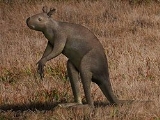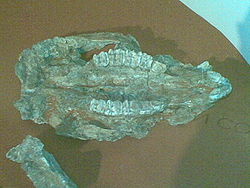
Sthenurus
Encyclopedia
Sthenurus is an extinct genus of kangaroo. With a length of about 3 m (10 ft), some species were twice as large as modern extant species. Sthenurus was related to the better-known Procoptodon
.
 Research by Darren R. Gröcke from Monash University
Research by Darren R. Gröcke from Monash University
, analysed the diets of fauna at various fossil site localites in South Australia
, using stable carbon isotope analysis 13C/12C of collagen
. He found that at older localities like Cooper Creek
the Sthenurus sp. was adapted to a diet of leaves and twigs (browsing). This was due to the wet climate of the time period between 132,000-108,000 years (TL
and uranium
dating), which allowed for a more varied vegetation cover.
At the Baldina Creek fossil site 30,000 years (C14
dating), the genus had adapted to a diet of grasses (grazing
). At this time the area was open grasslands with sparse tree cover as the continent was drier than today. But at Dempsey's Lake ( 36-25,000 years) and Rockey River (19,000 C14 dating), their diet was of both grazing and browsing. This analysis may be because of a wetter climatic period. The overall anatomy of the genus did not evolve for the change in diet and dentition did not adapt to the varying toughness of the vegetation between grasses, shrubs and trees.
Other species found in the Cuddie Springs habitat were the flightless bird Genyornis
, the Red kangaroo
, the Diprotodon
, humans and many others.
. At the end of the foot was a small hoof like nail suited for flat terrain; this toe is considered their fourth toe.
Their skeletal structure was very robust with powerful hind limbs, broad pelvis, longer arms and phalanges than modern species and a short neck. Their phalangel bones that make up their fingers may have been used to hold stems and twigs. These unique adaptations suited their feeding habits of browsing in the case of S. occidentalis, but other species were most likely grazers.
They possessed a short deep skull which was suited for eyes with stereoscopic vision; this allowed for better vision.
, useful for tough vegetation and with a striation pattern.
according to Judith Field and Richard Fullagerit (as cited in Macey 2003) it is known that Native Australians inhabited the same habitat as that of Sthenurus and various other extant and extinct species of animal. At this locality there seems to be a lack of any specific tools suitable for hunting. Instead there are tools used to cut meat off the bone, as there is blood residue left on the stone tools. Any material made of wood for hunting like the boomerang
and spear
has either not survived intact or was not used by the people of the time in this locality.
Procoptodon
Procoptodon was a genus of giant short-faced kangaroo living in Australia during the Pleistocene epoch. P. goliah, the largest known kangaroo that ever existed, stood approximately 2 meters tall. They weighed about ....
.
Fossil habitats

Monash University
Monash University is a public university based in Melbourne, Victoria. It was founded in 1958 and is the second oldest university in the state. Monash is a member of Australia's Group of Eight and the ASAIHL....
, analysed the diets of fauna at various fossil site localites in South Australia
South Australia
South Australia is a state of Australia in the southern central part of the country. It covers some of the most arid parts of the continent; with a total land area of , it is the fourth largest of Australia's six states and two territories.South Australia shares borders with all of the mainland...
, using stable carbon isotope analysis 13C/12C of collagen
Collagen
Collagen is a group of naturally occurring proteins found in animals, especially in the flesh and connective tissues of mammals. It is the main component of connective tissue, and is the most abundant protein in mammals, making up about 25% to 35% of the whole-body protein content...
. He found that at older localities like Cooper Creek
Cooper Creek
Cooper Creek is one of the most famous and yet least visited rivers in Australia. It is sometimes known as the Barcoo River from one of its tributaries and is one of three major Queensland river systems that flow into the Lake Eyre Basin...
the Sthenurus sp. was adapted to a diet of leaves and twigs (browsing). This was due to the wet climate of the time period between 132,000-108,000 years (TL
Thermoluminescence dating
Thermoluminescence dating is the determination, by means of measuring the accumulated radiation dose, of the time elapsed since material containing crystalline minerals was either heated or exposed to sunlight...
and uranium
Uranium
Uranium is a silvery-white metallic chemical element in the actinide series of the periodic table, with atomic number 92. It is assigned the chemical symbol U. A uranium atom has 92 protons and 92 electrons, of which 6 are valence electrons...
dating), which allowed for a more varied vegetation cover.
At the Baldina Creek fossil site 30,000 years (C14
Carbon-14
Carbon-14, 14C, or radiocarbon, is a radioactive isotope of carbon with a nucleus containing 6 protons and 8 neutrons. Its presence in organic materials is the basis of the radiocarbon dating method pioneered by Willard Libby and colleagues , to date archaeological, geological, and hydrogeological...
dating), the genus had adapted to a diet of grasses (grazing
Grazing
Grazing generally describes a type of feeding, in which a herbivore feeds on plants , and also on other multicellular autotrophs...
). At this time the area was open grasslands with sparse tree cover as the continent was drier than today. But at Dempsey's Lake ( 36-25,000 years) and Rockey River (19,000 C14 dating), their diet was of both grazing and browsing. This analysis may be because of a wetter climatic period. The overall anatomy of the genus did not evolve for the change in diet and dentition did not adapt to the varying toughness of the vegetation between grasses, shrubs and trees.
Other species found in the Cuddie Springs habitat were the flightless bird Genyornis
Genyornis
Genyornis was a monotypic genus of large, flightless bird that lived in Australia until 50±5 thousand years ago. Many species became extinct in Australia around that time, coinciding with the arrival of humans....
, the Red kangaroo
Red Kangaroo
The Red Kangaroo is the largest of all kangaroos, the largest mammal native to Australia, and the largest surviving marsupial. It is found across mainland Australia, avoiding only the more fertile areas in the south, the east coast, and the northern rainforests.-Description:This species is a very...
, the Diprotodon
Diprotodon
Diprotodon, meaning "two forward teeth", sometimes known as the Giant Wombat or the Rhinoceros Wombat, was the largest known marsupial that ever lived...
, humans and many others.
Anatomy
In anatomy they had a tail shorter but stronger than present species of Kangaroo, and only one toe instead (monodactyl) of three like the Red KangarooRed Kangaroo
The Red Kangaroo is the largest of all kangaroos, the largest mammal native to Australia, and the largest surviving marsupial. It is found across mainland Australia, avoiding only the more fertile areas in the south, the east coast, and the northern rainforests.-Description:This species is a very...
. At the end of the foot was a small hoof like nail suited for flat terrain; this toe is considered their fourth toe.
Their skeletal structure was very robust with powerful hind limbs, broad pelvis, longer arms and phalanges than modern species and a short neck. Their phalangel bones that make up their fingers may have been used to hold stems and twigs. These unique adaptations suited their feeding habits of browsing in the case of S. occidentalis, but other species were most likely grazers.
They possessed a short deep skull which was suited for eyes with stereoscopic vision; this allowed for better vision.
Teeth
These structures were tough and strongly enameledTooth enamel
Tooth enamel, along with dentin, cementum, and dental pulp is one of the four major tissues that make up the tooth in vertebrates. It is the hardest and most highly mineralized substance in the human body. Tooth enamel is also found in the dermal denticles of sharks...
, useful for tough vegetation and with a striation pattern.
Human interaction
From evidence gathered at Cuddie SpringsCuddie Springs
Cuddie Springs is a notable archaeological and paleontological site in the semi-arid zone of central northern New South Wales, Australia . Cuddie Springs is an open site, with the fossil deposits preserved in a claypan on the floor of an ancient ephemeral lake...
according to Judith Field and Richard Fullagerit (as cited in Macey 2003) it is known that Native Australians inhabited the same habitat as that of Sthenurus and various other extant and extinct species of animal. At this locality there seems to be a lack of any specific tools suitable for hunting. Instead there are tools used to cut meat off the bone, as there is blood residue left on the stone tools. Any material made of wood for hunting like the boomerang
Boomerang
A boomerang is a flying tool with a curved shape used as a weapon or for sport.-Description:A boomerang is usually thought of as a wooden device, although historically boomerang-like devices have also been made from bones. Modern boomerangs used for sport are often made from carbon fibre-reinforced...
and spear
Spear
A spear is a pole weapon consisting of a shaft, usually of wood, with a pointed head.The head may be simply the sharpened end of the shaft itself, as is the case with bamboo spears, or it may be made of a more durable material fastened to the shaft, such as flint, obsidian, iron, steel or...
has either not survived intact or was not used by the people of the time in this locality.

